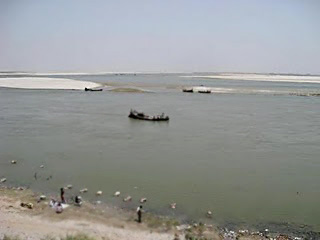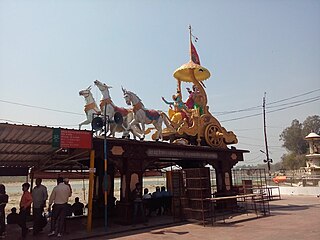 W
WGhat, a term used in the Indian subcontinent, depending on the context could refer either to a range of stepped hills with valleys, such as the Eastern Ghats and Western Ghats; or the series of steps leading down to a body of water or wharf, such as a bathing or cremation place along the banks of a river or pond, the Ghats in Varanasi, Dhobi Ghat or the Aapravasi Ghat. Roads passing through ghats are called Ghat Roads.
 W
WGandhi Ghat is one of the main ghats on the Ganges River in Patna. It is named after the leader of the Indian independence movement Mahatma Gandhi. The ghat is famous for its Evening Ganga Aarti. It is also associated with the immersion of ashes of Mahatma Gandhi in the river Ganges.
 W
WGurdwara Sri Guru Gobind Singh Ghat, also known as Gurudwara Kangan Ghat, is a Sikh place of worship on the banks of the Ganges River approximately 650 m (710 yd) from Takht Sri Patna Sahib. In sikh historical sources, this is the place where Guru Gobind Singh threw his gold bangle (kangan) and passed on the knowledge of Sri Guru Granth Sahib Ji to Pandit Shiv Dutt, a devotee of Sri Ram Chandra.
 W
WHar Ki Pauri is a famous ghat on the banks of the Ganges in Haridwar in the Indian state of Uttarakhand. This revered place is the major landmark of the holy city of Haridwar. Literally, "Har" means "God", "Ki" means " 's " and "Pauri" means "steps". Lord Vishnu is believed to have visited the Brahmakund in Har Ki Pauri in the Vedic times.
 W
WKastaharni Ghat is a ghat or bathing place on the River Ganges, at Munger in the Indian state of Bihar.
 W
WSatti Chaura Ghat or Massacre Ghat is a famous ghat in Kanpur, the industrial hub of Uttar Pradesh state in north India. It is located on the bank of the River Ganges in Kanpur Cantonment near Jajmau.
 W
WRam ki Paidi is a series of ghats on the bank of River Saryu in Ayodhya in the Indian state of Uttar Pradesh. A large number of pilgrims visit every day to take a sacred bath in holy Saryu waters. The river front brings forth a majestic landscape specially in floodlit night.
 W
WSethani Ghat is a 19th-century construction along the banks of the river Narmada at Narmadapuram in Madhya Pradesh in India. It is one of the largest ghats in India. During Narmada Jayanti celebrations the ghat comes alive when thousands of people converge on the ghats and diyas are floated in the river. The ghat was built after generous contributions by Jankibai Sethani from the Sharma family in Hoshangabad after devotees complained to her about the difficulty in getting to the river, Hence the ghat is named after her. It is one of the few examples of public infrastructure built through private funding in India. A photo of Narmada from Sethani ghat can be seen in the book Jungle Rahe Taki Narmada Bahe!, by Pankaj Srivastava.
 W
WThe Steam House is an 1880 Jules Verne novel recounting the travels of a group of British colonists in the Raj in a wheeled house pulled by a steam-powered mechanical elephant. Verne uses the mechanical house as a plot device to have the reader travel in nineteenth-century India. The descriptions are interspersed with historical information and social commentary.
 W
WTriveni Ghat is a ghat situated in Rishikesh, Uttarakhand. It is the biggest and most famous ghat in Rishikesh at the banks of Ganges. Triveni Ghat remains overcrowded with devotee to take ritual baths to get cleansed from their sins. It is believed that the ghat was visited by Lord Krishna when he got hurt by the arrow of Jara – a hunter. Being the most venerated ghat in Rishikesh, Triveni Ghat is even used by devotees to perform the last rites and rituals of their loved ones. The ghat is famed for the Ganga aarti performed to the chants of Vedic hymns. The sight of oil leaves, filled with diya and petals, which are released by devotees, floating on the pristine Ganga and the traditional aarti is a sight to behold. On the bank of Triveni Ghat, one can visit the Gita Mandir and Lakshminarayan Temple. Dawn boat ride along the Ganges is a must on a short tour to Triveni Ghat.
 W
WVishram Ghat is a ghat, a bath and worship place, on the banks of river Yamuna in Mathura, India. It is the main ghat of Mathura and is central to 25 other ghats. The traditional parikrama starts and ends at Vishram Ghat. Lord Krishna is said to have rested at this place after killing Kansa.